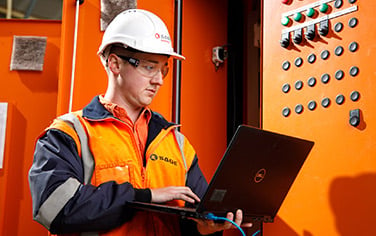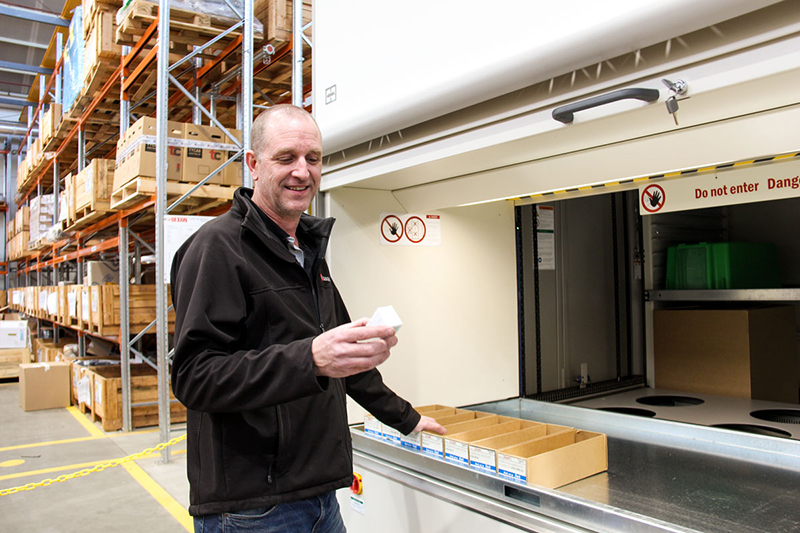The benefits of spares inventory management for manufacturing maintenance
Deon McHatton, Published: August 31, 2017 - Updated: February 25, 2020 (5 min read)
Having spare parts on hand is a crucial aspect of manufacturing maintenance, as every plant needs to carry a certain amount of spares to be able to recover in the event of a failure.
Some maintenance or operations managers will say they want one of everything kept in their stores, but that’s just not feasible, especially if the business wants to reduce inventories by 10%.
Spares holding represents capital expenditure on products that return no bottom line contribution. Multiple spares also require additional real estate to store. So by reducing spares, you’re reducing space waste and holding costs.
A standardised spare parts regime is the best way to ensure downtime is reduced, while also optimising inventory control. We talked to SAGE Automation's National Service Manager Deon McHatton about the benefits and importance of parts standardisation in manufacturing maintenance and what the best practices are.
What is parts standardisation? Why should I standardise spare parts?
There are a few good reasons:
Save capital expenditure on parts
If you have non-standard equipment on-site, you need to carry a lot more spares, because they're all different brands, models and vintages. This means more capital is spent on purchasing spares. That capital is bad capital, because it’s sitting on the shelf.
Here’s a few other financial benefits of parts standardisation:
- A list of approved standard parts stops the wrong parts from being ordered.
- A warehouse with minimal parts is more likely to be orderly, meaning there’s less chance of something being misplaced and ordered by accident, or not being reordered once it's been used.
- Standardisation involves stocking critical parts, not all parts, which minimises spares expenditure, freeing up this cash to do plant improvements.
Optimise your space
A reduced inventory of spare parts can drastically increase available floor or vertical space, opening up new production or optimisation opportunities.
Have more capable, better trained staff
Standardising equipment means you can target training to just one or two sets of equipment, rather than 5 or 10 or more. This allows staff to maintain currency on key equipment, learn to solve problems and even improve maintenance programs.
Make repairs simpler
Standardisation allows parts to be immediately ‘pulled into assembly’, rather than having to order it and wait for it to be delivered. Plus, staff with knowledge of standardised equipment and parts are able to repair it quicker when it fails.
Recover quicker from faults, thereby reducing downtime
Having selected spares on hand enables plants to bounce back quickly from downtime. Standardised parts will likely be stocked, labelled and easily found when needed. Plus keeping parts top of mind means you’ll have a better idea of the vendor supply arrangement – you won’t get caught waiting for an out-of-stock or ‘no longer manufactured’ part.
Simplify vendor supply chain
Standardisation can simplify the way the business handles ordering and stocking of spare parts. Business-wide savings include the reduction in supplier accounts managed by finance and less processing by warehouse and inventory departments.
Reduce total cost of ownership (TCO) for equipment
Cheaper equipment may suit the ‘run it till it breaks’ approach, but will require non-standard spares to be kept on-hand, and more warehouse space. Quality equipment that staff can maintain will reduce your spares inventory, reduce TCO and optimise floor space.
How should I standardise parts?
Everyone will do this differently, but here are some best-practice approaches in this area:
- Start with finding your equipment criticality rating. Then ensure you have the spare parts stocked for the most critical pieces of equipment. Even better, work towards standardised equipment, so it’s easier to maintain a standardised set of parts.
-
Now clean out, label and reorder inventory. Remove excess part varieties. If a part can be used for multiple purposes, keep this on hand and ditch duplicates. Lean 5s provides a good framework.
- Look at how you’re storing your electrical boards, bearings, gearboxes belts, etc. Get advice from your supplier representative – they’re exposed to a range of plants and might be able to tell you how others are doing it better.
- If you’re lucky enough to be involved in a new product line, try the zero-based approach to parts, which asks "What is the minimum list of part types we need?”
- Research suppliers and understand their locality and production process. Order critical parts that take time to make and deliver.
- Document your standard suppliers and parts so other areas of the business and key staff are aware. Why? With up to date documentation and listing of standard suppliers the company is not at risk of relying on information only stored in someone’s memory. What happens when that person leaves or is unavailable?
- Schedule inventory checks into your pre-existing manufacturing maintenance regime.
- Train operations and maintenance staff on any changes in equipment.
- Finally, consider parts standardisation in all projects. Often, capital expenditure projects are controlled by people who are usually not those tasked with maintaining the equipment. These projects can fail to consider the system’s lifespan in efforts to meet the project budget. Push to use standardised parts in projects as this will contribute to improving the TCO of equipment and ensure smooth plant production.
When a machine stops, it can quickly escalate to calling in external help – sometimes unnecessarily. The Breakdown Checklist is designed to get you back online faster. It will get your team thinking about what caused the breakdown and assess the need for external advice. Download the free downtime checklist here.
SAGE Automation delivers agile, scalable and secure solutions that don’t just solve current problems, they preempt and deter future ones, helping your organisation thrive. With years of experience working in defence, infrastructure, resources, utilities and manufacturing we have the expertise you need to custom-build or perform manufacturing maintenance on your equipment for maximum ROI.








